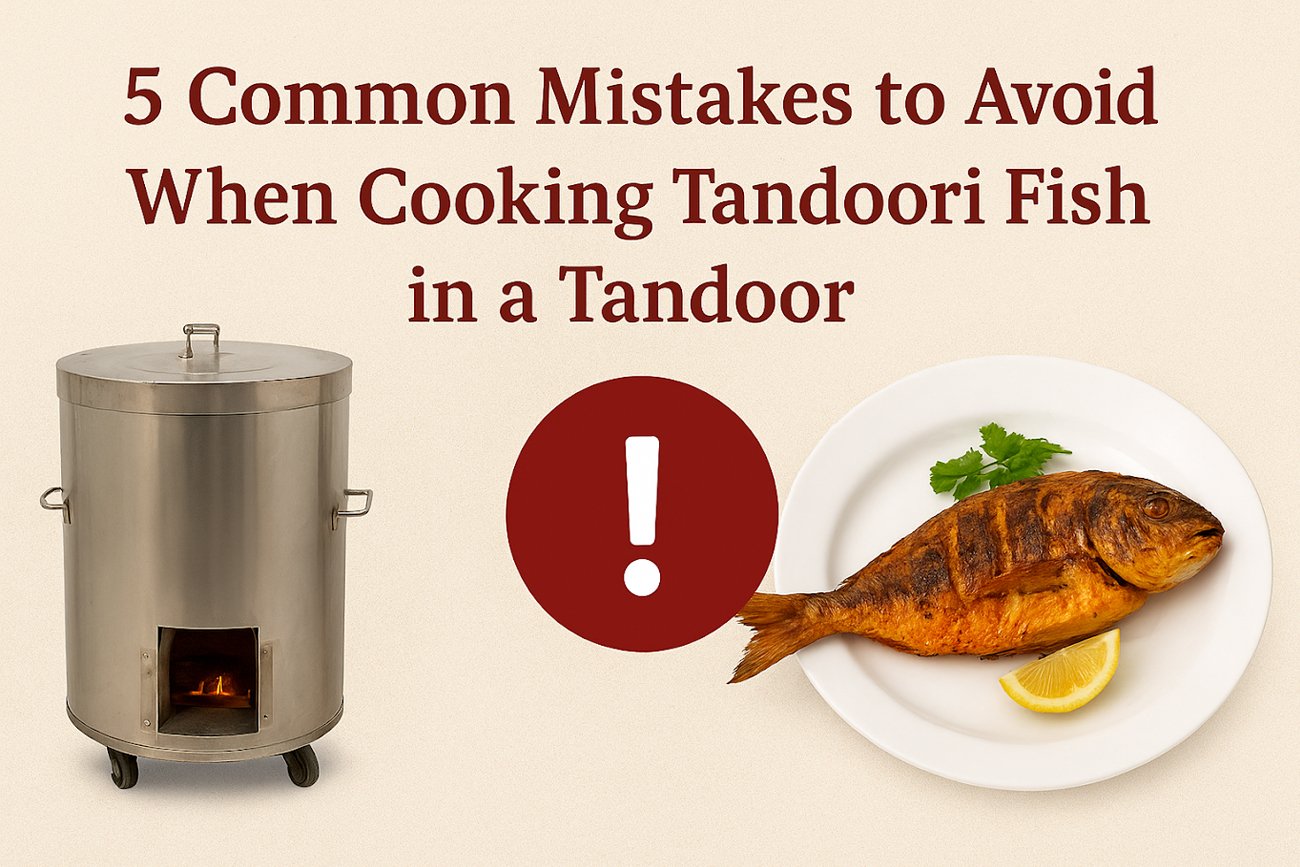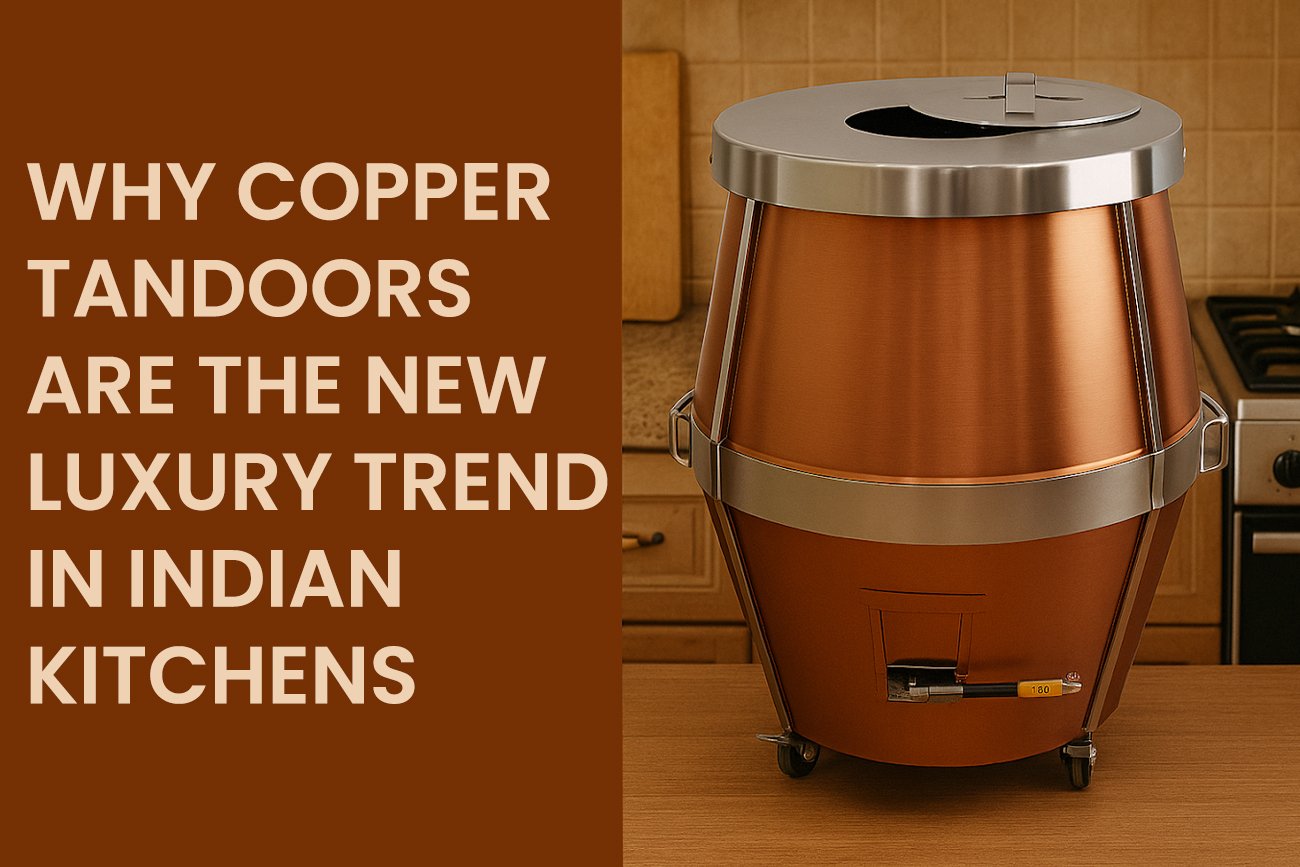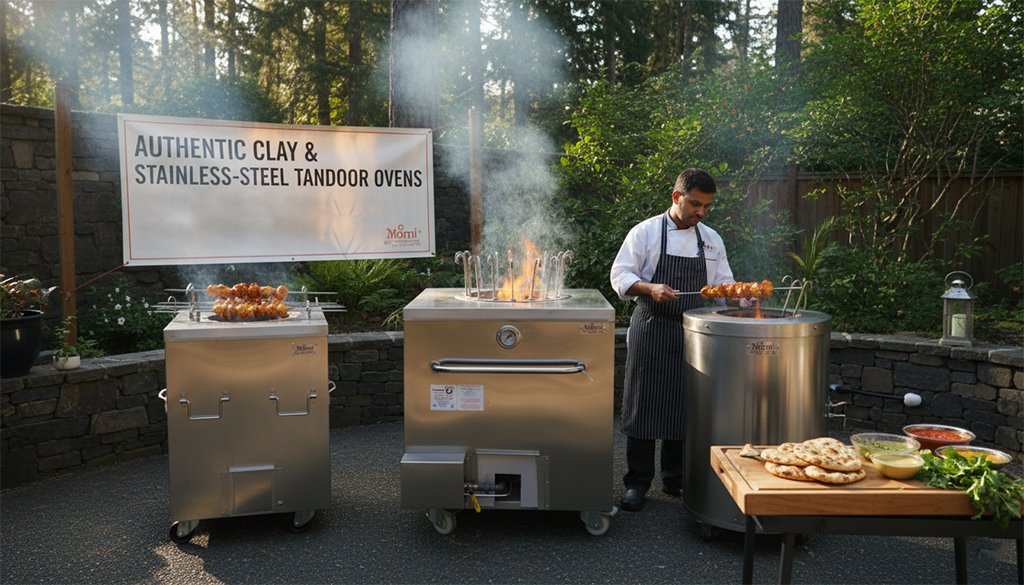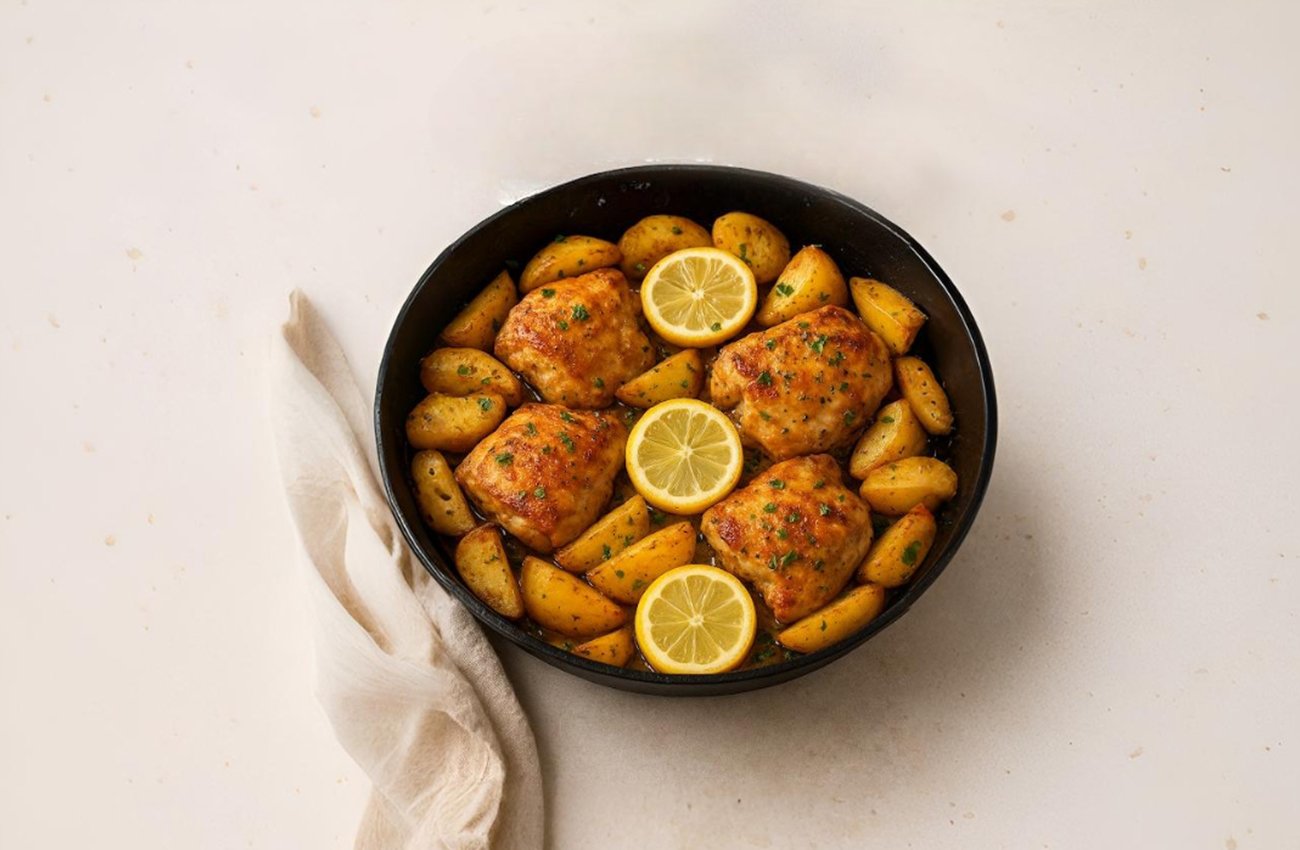
The Complete Guide to Cooking with a Tandoor Oven
The Tandoor Oven has been a key part of Indian cooking for centuries. It’s famous for its ability to cook delicious dishes quickly at very high temperatures. If you’ve ever enjoyed a fresh piece of naan bread, then you know how special food cooked in a Tandoor Oven can be. When you stick the dough to the hot clay walls, it bubbles up and gets those perfect charred spots, giving you crispy yet fluffy naan bread.
But the Tandoor Oven isn’t just about making bread. Its real magic lies in how it traps and uses heat. Once it reaches a certain temperature, it can stay hot for a long time without needing more fuel. This not only saves time but also gives the food a unique, smoky flavor that’s hard to match with any other cooking method.
How to Choose the Right Tandoor Oven?
Adding a Tandoor Oven to your kitchen is a great way to bring authentic flavors into your home cooking. You can make the same mouthwatering dishes at home that you enjoy in traditional Indian or South Asian restaurants. But choosing the right Tandoor Oven is important to get the best results. The wrong choice could leave you struggling with setup or maintenance issues, or even paying too much for something that doesn’t meet your needs.
There are different factors to consider when buying a Tandoor Oven, including its size, fuel type, materials, and the brand’s reputation. Let’s dive into each of these factors to help you make the right choice.
1. Size: Consider Your Cooking Needs
The size of the Tandoor Oven matters a lot. Think about how much food you plan to cook and how much space you have for the oven. If you have a large family or often entertain guests, you may want a bigger oven. But if you’re cooking for one or two people or have limited space, a smaller oven will be more practical.
A bigger Tandoor Oven can cook large quantities of food at once, making it ideal for parties or family gatherings. On the other hand, a smaller oven will heat up quicker and be easier to manage, making it a good choice for beginners.
2. Fuel: Choose the Right Heat Source
Tandoor Ovens can run on different types of fuel, such as charcoal, wood, gas, or even electric power. Each type has its own benefits and drawbacks, so think about your comfort level with each heat source.
-
- Charcoal or Wood: These types of Tandoor Ovens offer a more traditional cooking experience. They provide that authentic smoky flavor but require more skill to control the temperature. You’ll need to adjust the coals or wood frequently to maintain the right heat.
-
- Gas: A gas Tandoor Oven is easier to control because you can adjust the heat by turning a knob. It’s great for those who are new to tandoori cooking but still want that traditional experience.
-
- Electric: These are the easiest to use and maintain. You can set the temperature just like a regular oven. However, electric Tandoor Ovens may not give you the same smoky flavor as charcoal or wood.
3. Materials: What’s It Made Of?
Tandoor Ovens come in different materials, and each type has its own benefits. Choosing the right material depends on what kind of cooking you plan to do and how you want your food to taste.
-
- Clay: Traditional Tandoor Ovens are made of clay. This material holds heat very well and gives food that classic earthy flavor. However, clay ovens need proper care to avoid cracks. You’ll need to soak it in water before the first use and during long periods of non-use.
-
- Stainless Steel: These are more modern Tandoor Ovens. They have a clay lining inside but a stainless steel body on the outside. They are easier to clean and last longer than pure clay models. Plus, they heat up quickly.
4. Brand Reputation: Trust Matters
Before you buy a Tandoor Oven, do some research on the brand. Check reviews and see what other customers are saying. Make sure the brand has a good reputation for quality and customer service. This step can save you a lot of trouble in the long run. Brands that specialize in Tandoor Ovens often offer better support and more reliable products than brands that don’t.
How to Use a Tandoor Oven for Authentic Cooking
Cooking with a Tandoor Oven can seem a bit tricky at first. But with a little practice, you can master the basics and make mouthwatering dishes that taste just as good as those from a restaurant. Here’s how to get started:
1. Preparation: Get Your Oven Ready
If you’re using a clay Tandoor Oven, it needs some preparation before cooking. Soak the clay in water for a few hours to prevent cracking. This helps the clay stay strong even in high heat. For a stainless steel Tandoor Oven, it’s a good idea to heat it up for a while before cooking. This will burn off any manufacturing residue or dust.
2. Temperature: Keep It High and Steady
A Tandoor Oven needs to be very hot to cook food properly. Temperatures often reach over 500°C (about 932°F). High heat cooks the food quickly and gives it that special charred flavor. Keep a close eye on the temperature while cooking. Some dishes need a little more heat than others, and adjusting the temperature can make a big difference in how your food turns out.
3. Cooking: What Can You Make?
There’s almost no limit to what you can cook in a Tandoor Oven. Here are some of the classic dishes that you should definitely try:
-
- Tandoori Chicken: This dish is famous for its spicy marinade and charred skin. It’s cooked directly on skewers inside the Tandoor Oven, where the high heat seals in the juices.
-
- Chicken Tikka: Similar to tandoori chicken, but cut into smaller pieces. It’s often used as an appetizer or main dish.
-
- Lamb Kebabs: The oven’s heat cooks the lamb evenly, making the outside crispy while the inside stays tender.
-
- Naan Bread: Stick the dough to the hot walls of the oven, and it will bubble up to form a soft, fluffy bread with crispy edges.
-
- Vegetables: You can also roast vegetables like bell peppers, onions, mushrooms, and potatoes. The intense heat brings out the natural sweetness of the vegetables and adds a smoky flavor.
Tips for Perfect Cooking in Your Tandoor Oven
Here are some quick tips that can help you get the best results from your Tandoor Oven:
-
- Use the Right Skewers: Different foods need different types of skewers. Thinner skewers work best for vegetables and seafood, while thicker skewers are better for meat.
-
- Marinate Your Food: A good marinade not only adds flavor but also helps keep the food moist in the high heat. Use yogurt, lemon juice, and spices for a traditional marinade.
-
- Don’t Overcrowd the Oven: Give your food enough space. This helps it cook evenly. If you put too many items in at once, the heat won’t circulate properly.
How to Maintain Your Tandoor Oven
A Tandoor Oven is a valuable cooking tool, and with the right care, it can last for many years. Here’s how to keep your oven in good shape:
1. Cleaning the Oven: Keep It Hygienic
Even though Tandoor Ovens don’t need a lot of cleaning, it’s important to keep them hygienic. For a clay oven, you don’t have to scrub it often, but cleaning the burner area twice a year is a good practice. Use a brass brush to scrub the clay plates and remove any buildup.
For a stainless steel Tandoor Oven, you can wipe down the inside with a damp cloth. Make sure the oven has cooled down before you start cleaning. If you find any residue that’s hard to remove, heat the oven slightly to loosen it.
2. Cleaning the Skewers: Don’t Let Food Stick Around
Skewers can get dirty quickly, especially after cooking meat. Clean them thoroughly after each use. Wash stainless steel skewers with soap and water, then dry them well. If you see rust on the skewers, rub it off with some aluminum foil.
Brush the skewers with vegetable oil to help keep them in good condition. This helps prevent rust and makes cleaning easier the next time you use them. Place the skewers back inside the Tandoor Oven for about 10-15 minutes to get rid of any remaining dirt or dust.
3. Storing the Oven: Keep It Covered
If you keep your Tandoor Oven outside, protect it from rain and snow. Use a cover to keep it dry. This will help prevent cracks in clay ovens and rust in stainless steel ovens. For indoor storage, make sure the oven is completely cool before covering it to avoid trapping moisture inside.
Choosing Between Different Types of Tandoor Ovens
Not all Tandoor Ovens are the same. The kind you choose depends on your needs, the type of food you want to cook, and the experience you have with tandoori cooking. Let’s look at the various types available to help you decide which one suits you best.
1. Traditional Clay Tandoor Ovens
These are the original Tandoor Ovens. They’re made from clay and have been used for centuries in Indian and Middle Eastern cooking. The clay adds a special flavor to the food. However, they need more care than other types. You have to soak them in water before use and keep them from drying out completely.
Pros:
-
- Adds a unique, earthy flavor to food
-
- Perfect for making naan and other traditional dishes
Cons:
-
- Requires more maintenance
-
- Heavier and harder to move
2. Stainless Steel Tandoor Ovens
These modern Tandoor Ovens combine the best of both worlds. They have a stainless steel exterior and a clay interior lining. This design makes them easier to clean and more durable. You can find them in various sizes, from small home models to large commercial versions.
Pros:
-
- Easy to clean
-
- Heats up quickly
-
- Long-lasting
Cons:
-
- More expensive than traditional clay ovens
-
- May not provide the same smoky flavor
3. Portable Tandoor Ovens
Portable Tandoor Ovens are perfect for people who like to cook outdoors. They’re smaller and lighter, making them easy to transport. You can use them in your backyard, at a picnic, or even when camping. They typically use charcoal or wood for fuel.
Pros:
-
- Easy to move around
-
- Great for outdoor cooking
Cons:
-
- Smaller size means you can cook less at one time
-
- May not reach the same high temperatures as larger models
4. Gas Tandoor Ovens
Gas-powered Tandoor Ovens are popular for their ease of use. You can control the temperature with a simple turn of a knob. This makes them great for beginners who are not used to controlling heat levels manually.
Pros:
-
- Easy temperature control
-
- Great for beginners
Cons:
-
- Doesn’t give the same traditional smoky flavor
-
- Requires a gas connection
Making the Most of Your Tandoor Oven: Recipes and Techniques
Now that you have your Tandoor Oven set up and know how to maintain it, it’s time to start cooking. Here are some traditional dishes you can make and tips to help you achieve the best results.
Naan Bread Recipe
Ingredients:
-
- 2 cups all-purpose flour
-
- 1/2 cup yogurt
-
- 1/4 cup warm water
-
- Table Salt, 1 tsp
-
- Sugar, 1 tsp
-
- Baking Powder, 1 tsp
-
- 1 tbsp olive oil
Instructions:
-
- Mix the flour, salt, sugar, and baking powder in a bowl.
-
- Add the yogurt and warm water. Mix until it forms a dough.
-
- Knead the dough for about 5 minutes. Let it rest for 30 minutes.
-
- Divide the dough into small balls. Roll them out into flat circles.
-
- Stick the dough to the walls of the Tandoor Oven. Cook for 1-2 minutes or until the bread puffs up and gets charred spots.
-
- Brush with butter before serving.
Tandoori Chicken Recipe
Ingredients:
-
- 1 whole chicken, cut into pieces
-
- 1 cup yogurt
-
- 2 tbsp lemon juice
-
- 2 tbsp ginger-garlic paste
-
- 1 tsp cumin powder
-
- 1 tsp chili powder
-
- Salt to taste
Instructions:
-
- Mix all the ingredients except the chicken to make a marinade.
- Coat the chicken with the marinade. Let it sit for at least 4 hours.
- Skewer the chicken pieces and place them in the Tandoor Oven.
- Cook for 20-30 minutes, turning occasionally, until the chicken is fully cooked and has a nice char on the outside.
Why Every Home Cook Should Try a Tandoor Oven
Cooking with a Tandoor Oven adds a whole new dimension to your culinary skills. It’s not just about making food; it’s about experiencing a traditional cooking method that brings unique flavors to your table. The Tandoor Oven lets you try a wide variety of dishes that you can’t easily make with other ovens.
You don’t have to be a professional chef to enjoy the benefits of a Tandoor Oven. With a bit of practice, you can impress your friends and family with homemade naan, kebabs, and other tasty dishes. Plus, the oven’s design allows you to cook without using a lot of oil, making it a healthier option for preparing meals.
Need Help? Order and Technical Support
Have questions or ready to place an order? Reach out to us via phone at +1(727) 251 6924 or email us at info@tandoormorni.com.
Need detailed instructions? Explore the Operation Manual for our CH & CS models to get started with your Tandoor oven today.
About Tandoor Morni
Tandoor Morni, in business since 1992, is a trusted name in premium Tandoori Clay Ovens, known for crafting high-quality traditional and commercial tandoors. With a commitment to excellence, Tandoor Morni offers a wide range of tandoors, including commercial, residential, catering, and copper models. Our tandoors are built with durable materials and designed for efficient heat distribution, ensuring authentic flavors and fast cooking. Each oven features customizable options like gas, wood fire, or charcoal compatibility, making them suitable for various cooking needs.
Common Queries – FAQ’S
Can I use a tandoor Indoors?
Yes, certain tandoor models are designed for residential use, including compact, home-friendly versions. However, using a tandoor indoors requires proper ventilation and adherence to safety precautions to manage high heat and potential smoke. Always consult the manufacturer’s guidelines to ensure safe indoor use. For best results, they are often used in well-ventilated spaces or outdoors.
Are Tandoor-Cooked Foods Healthy?
Yes, tandoor-cooked foods are often considered healthy because they typically require little to no oil. The high cooking temperatures allow the food to cook quickly, preserving nutrients while reducing the need for additional fats. Additionally, the vertical cooking method allows excess fats to drip away, resulting in leaner dishes.
What Types of Fuel Can Be Used in a Tandoor?
Tandoors can be heated using charcoal, wood, natural gas or propane. Charcoal and wood provide an authentic smoky flavor, while natural gas or propane is more convenient and easier to control. The choice of fuel often depends on the specific cooking requirements and local regulations, especially in commercial settings.
How Does a Tandoor Oven Differ from a Conventional Oven?
Unlike conventional ovens, which use electric or gas heat, a tandoor is made from clay and uses charcoal, wood, or gas to heat the walls. The cylindrical shape and porous clay walls create an environment where heat circulates evenly, cooking food quickly while adding a smoky flavor. Conventional ovens, in contrast, lack the intense heat and unique cooking technique of a tandoor.
How Much Maintenance Does a Gas Tandoor Require?
Gas Tandoor needs regular maintenance, though less than Charcoal Tandoor models. Here’s a breakdown:
- Daily Maintenance: Wipe down the inner chamber and clean the burner.
- Weekly Maintenance: Check the burner and gas line for any blockages or leaks.
- Monthly Maintenance: Deep clean the gas pipes, burners, and inner chamber.
- Quarterly Maintenance: Have a professional inspect the gas connections and burners.
- Annual Maintenance: Perform a full inspection and reapply clay lining if needed.
Avoid exposing the tandoor to excessive water, and gradually increase heat to prevent cracks.
How Can I Make a Payment for My Tandoor Order?
You can pay for your tandoor order through our website by placing an online order using the available payment options. If you prefer to place an order over the phone, we accept payment via Zelle for a quick and secure transaction.
Which Tandoor Oven Size Should I Choose?
- For Home Use: Consider the number of family members or guests you typically serve. A mini tandoor is ideal for smaller gatherings.( Suggested Product: R26 )
- For Restaurants: Measure the entrance to ensure the oven fits through the door. Select a size based on available space and cooking needs. (Suggested Product: CH02)
- For Naan Bread: Opt for an oven with a smaller mouth opening, resulting in a more egg-shaped clay pot, perfect for naan preparation. For larger meat portions, choose a bigger oven to maintain heat longer. (Suggested Product: CH04)
- For Catering: A Clay Tandoor Oven is suitable for catering due to its lightweight and easy transport features. (Suggested Product: CS01)
- For Banquet Halls: A larger oven with a spacious clay pot is ideal for preparing multiple dishes quickly during big events. (Suggested Product: CH06)
- For Open Kitchens or Outdoor Patios: Choose a model with a decorative finish, such as a copper tandoor, to enhance the kitchen’s appearance with a touch of elegance. (Visit Our Copper Tandoor).
What Should You Consider When Installing a Restaurant Clay Oven?
- When installing a tandoor in your restaurant kitchen, consider the following:
- Space and Placement: Ensure there is enough clearance around the tandoor for ventilation and safety, with fireproof or heat-resistant flooring.
- Ventilation and Exhaust: Proper ventilation is essential to handle heat and smoke, especially with charcoal tandoors.
- Safety Measures: Use heat-resistant barriers if the tandoor is near other equipment, and keep fire safety equipment like extinguishers handy.
- Fuel Supply: Decide between charcoal, which offers traditional flavors, and gas, which is easier to manage.
By keeping these points in mind, you can ensure a safe and efficient tandoor setup. If you're looking for a Restaurant Clay Oven for Sale, make sure to choose a model that fits your kitchen's requirements and meets all necessary safety standards.
- Menu Considerations: Larger tandoors or multiple units may be needed if you have a diverse menu or high demand during peak hours.
- Maintenance and Cleaning: Clean the tandoor daily and monitor for any wear or damage to the clay or gas parts.
- Compliance with Regulations: Ensure your installation meets local safety standards and health codes.
- Staff Training: Train staff in safe tandoor operation and fire safety protocols.






